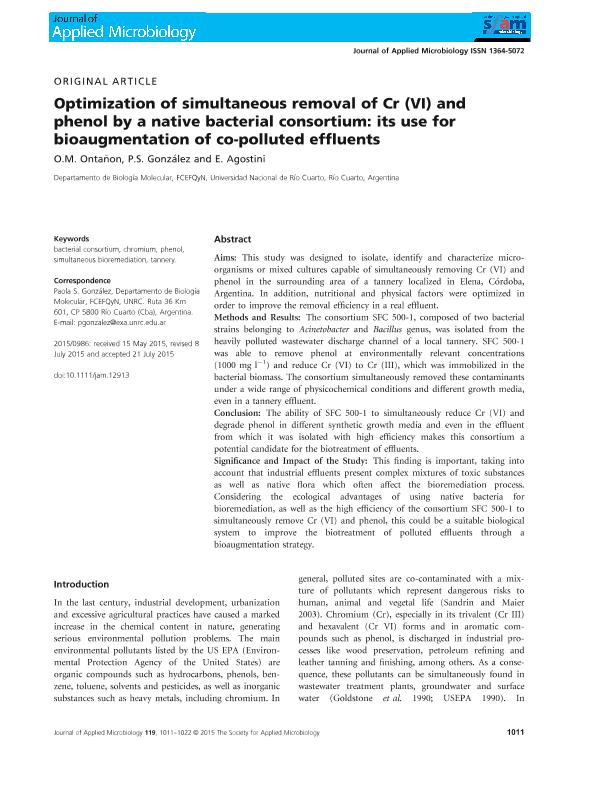Mostrar el registro sencillo del ítem
dc.contributor.author
Ontañon, Ornella Mailén

dc.contributor.author
González, Paola Solange

dc.contributor.author
Agostini, Elizabeth

dc.date.available
2019-02-04T18:06:53Z
dc.date.issued
2015-10
dc.identifier.citation
Ontañon, Ornella Mailén; González, Paola Solange; Agostini, Elizabeth; Optimization of simultaneous removal of Cr (VI) and phenol by a native bacterial consortium: Its use for bioaugmentation of co-polluted effluents; Wiley Blackwell Publishing, Inc; Journal of Applied Microbiology; 119; 4; 10-2015; 1011-1022
dc.identifier.issn
1364-5072
dc.identifier.uri
http://hdl.handle.net/11336/69318
dc.description.abstract
Aims: This study was designed to isolate, identify and characterize micro-organisms or mixed cultures capable of simultaneously removing Cr (VI) and phenol in the surrounding area of a tannery localized in Elena, Córdoba, Argentina. In addition, nutritional and physical factors were optimized in order to improve the removal efficiency in a real effluent. Methods and Results: The consortium SFC 500-1, composed of two bacterial strains belonging to Acinetobacter and Bacillus genus, was isolated from the heavily polluted wastewater discharge channel of a local tannery. SFC 500-1 was able to remove phenol at environmentally relevant concentrations (1000 mg l-1) and reduce Cr (VI) to Cr (III), which was immobilized in the bacterial biomass. The consortium simultaneously removed these contaminants under a wide range of physicochemical conditions and different growth media, even in a tannery effluent. Conclusion: The ability of SFC 500-1 to simultaneously reduce Cr (VI) and degrade phenol in different synthetic growth media and even in the effluent from which it was isolated with high efficiency makes this consortium a potential candidate for the biotreatment of effluents. Significance and Impact of the Study: This finding is important, taking into account that industrial effluents present complex mixtures of toxic substances as well as native flora which often affect the bioremediation process. Considering the ecological advantages of using native bacteria for bioremediation, as well as the high efficiency of the consortium SFC 500-1 to simultaneously remove Cr (VI) and phenol, this could be a suitable biological system to improve the biotreatment of polluted effluents through a bioaugmentation strategy.
dc.format
application/pdf
dc.language.iso
eng
dc.publisher
Wiley Blackwell Publishing, Inc

dc.rights
info:eu-repo/semantics/openAccess
dc.rights.uri
https://creativecommons.org/licenses/by-nc-sa/2.5/ar/
dc.subject
Bacterial Consortium
dc.subject
Chromium
dc.subject
Phenol
dc.subject
Simultaneous Bioremediation
dc.subject
Tannery
dc.subject.classification
Otras Ciencias Biológicas

dc.subject.classification
Ciencias Biológicas

dc.subject.classification
CIENCIAS NATURALES Y EXACTAS

dc.title
Optimization of simultaneous removal of Cr (VI) and phenol by a native bacterial consortium: Its use for bioaugmentation of co-polluted effluents
dc.type
info:eu-repo/semantics/article
dc.type
info:ar-repo/semantics/artículo
dc.type
info:eu-repo/semantics/publishedVersion
dc.date.updated
2019-02-04T13:14:59Z
dc.journal.volume
119
dc.journal.number
4
dc.journal.pagination
1011-1022
dc.journal.pais
Reino Unido

dc.journal.ciudad
Londres
dc.description.fil
Fil: Ontañon, Ornella Mailén. Consejo Nacional de Investigaciones Científicas y Técnicas. Centro Científico Tecnológico Conicet - Córdoba; Argentina. Universidad Nacional de Río Cuarto. Facultad de Ciencias Exactas Fisicoquímicas y Naturales. Departamento de Biología Molecular; Argentina
dc.description.fil
Fil: González, Paola Solange. Consejo Nacional de Investigaciones Científicas y Técnicas. Centro Científico Tecnológico Conicet - Córdoba; Argentina. Universidad Nacional de Río Cuarto. Facultad de Ciencias Exactas Fisicoquímicas y Naturales. Departamento de Biología Molecular; Argentina
dc.description.fil
Fil: Agostini, Elizabeth. Consejo Nacional de Investigaciones Científicas y Técnicas. Centro Científico Tecnológico Conicet - Córdoba; Argentina. Universidad Nacional de Río Cuarto. Facultad de Ciencias Exactas Fisicoquímicas y Naturales. Departamento de Biología Molecular; Argentina
dc.journal.title
Journal of Applied Microbiology

dc.relation.alternativeid
info:eu-repo/semantics/altIdentifier/doi/https://doi.org/10.1111/jam.12913
dc.relation.alternativeid
info:eu-repo/semantics/altIdentifier/url/https://onlinelibrary.wiley.com/doi/full/10.1111/jam.12913
Archivos asociados
